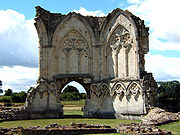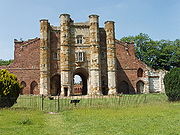
Thornton Abbey
Encyclopedia

William le Gros, 1st Earl of Albemarle
William le Gros was the Count of Aumale , Earl of York, and Lord of Holderness. He was the eldest son of Stephen, Count of Aumale, and his spouse, Hawise, daughter of Ralph de Mortimer of Wigmore....
, and raised to the status of Abbey in 1148. It was a house for Augustinian or black canons. These priests lived a communal life under the Rule of St Augustine but also undertook pastoral duties outside of the Abbey. Officers within the Abbey besides the abbot and prior included a cellarer, bursar, chamberlain, sacrist, kitchener and an infirmer. It is located close to the small North Lincolnshire
North Lincolnshire
North Lincolnshire is a unitary authority area in the region of Yorkshire and the Humber in England. For ceremonial purposes it is part of Lincolnshire....
village of Thornton Curtis
Thornton Curtis
Thornton Curtis is a village and parish in the North Lincolnshire district of Lincolnshire, England, about south east of the town of Barton-upon-Humber....
.
The abbey was closed in 1539 by Henry VIII
Henry VIII of England
Henry VIII was King of England from 21 April 1509 until his death. He was Lord, and later King, of Ireland, as well as continuing the nominal claim by the English monarchs to the Kingdom of France...
as part of the dissolution
Dissolution of the Monasteries
The Dissolution of the Monasteries, sometimes referred to as the Suppression of the Monasteries, was the set of administrative and legal processes between 1536 and 1541 by which Henry VIII disbanded monasteries, priories, convents and friaries in England, Wales and Ireland; appropriated their...
. Thornton was a wealthy and prestigious house valued at the dissolution
Dissolution of the Monasteries
The Dissolution of the Monasteries, sometimes referred to as the Suppression of the Monasteries, was the set of administrative and legal processes between 1536 and 1541 by which Henry VIII disbanded monasteries, priories, convents and friaries in England, Wales and Ireland; appropriated their...
at the considerable sum of £591 0s 2 ¾ d.
Thornton Abbey railway station
Thornton Abbey railway station
Thornton Abbey railway station is a railway station close to the site of Thornton Abbey in North Lincolnshire, England. It was built by the Great Grimsby and Sheffield Junction Railway in 1849, replacing one at Thornton Curtis. It also serves the village of Thornton Curtis and is managed by...
is nearby.
Architecture

Romanesque architecture
Romanesque architecture is an architectural style of Medieval Europe characterised by semi-circular arches. There is no consensus for the beginning date of the Romanesque architecture, with proposals ranging from the 6th to the 10th century. It developed in the 12th century into the Gothic style,...
in style, but nothing of it remains above ground.
The later abbey from the 13th/14th centuries was built in Early Gothic
Gothic architecture
Gothic architecture is a style of architecture that flourished during the high and late medieval period. It evolved from Romanesque architecture and was succeeded by Renaissance architecture....
style. Little remains of the building, except for three walls of the chapter house
Chapter house
A chapter house or chapterhouse is a building or room attached to a cathedral or collegiate church in which meetings are held. They can also be found in medieval monasteries....
and part of the cloister
Cloister
A cloister is a rectangular open space surrounded by covered walks or open galleries, with open arcades on the inner side, running along the walls of buildings and forming a quadrangle or garth...
, though the groundplan of the abbey is traced out.
The main interest lies in the gatehouse which is amongst the earliest largescale uses of brick
Brick
A brick is a block of ceramic material used in masonry construction, usually laid using various kinds of mortar. It has been regarded as one of the longest lasting and strongest building materials used throughout history.-History:...
in England. It stands two storeys high and is structurally intact. There are few windows in the building, and the internal dimensions are cramped due to the thickness of the walls.
The outside of the building is adorned with three almost lifesize statues directly above the gate. A bridge over the moat adjoins the gatehouse and is fortified with walls and guardrobes.
Since the dissolution the site has been owned by: Henry Randes (the Bishop of Lincoln); Sir Robert Tyrwhitt
Robert Tyrwhitt
-Life:Born in London, he was younger son of Robert Tyrwhitt , residentiary canon of St Paul's Cathedral, by his wife Elizabeth, eldest daughter of Edmund Gibson, bishop of London. Thomas Tyrwhitt was his eldest brother. He entered as a pensioner at Jesus College, Cambridge on 9 March 1753, and...
of Kettleby
Bigby, Lincolnshire
Bigby is a village and civil parish in the West Lindsey district of Lincolnshire, England. It lies about ten miles south of the Humber Bridge, and four miles east of the town of Brigg. The village lies in the Lincolnshire Wolds, a designated Area of Outstanding Natural Beauty and lies close to the...
; Sir Vincent Skinner
Vincent Skinner
Sir Vincent Skinner was an English politician, who sat in parliament for numerous constituencies.The son of John Skinner of Thorpe-by-Wainfleet, Lincolnshire, he matriculated at Trinity College, Cambridge in 1557, graduating B.A. in 1561 and M.A. in 1564.He was a Member of Parliament for Truro in...
of Westminster; Sir Robert Sutton
Robert Sutton (diplomat)
Sir Robert Sutton KB was an English diplomat and then politician.-Early life:He was the elder son of Robert Sutton of Averham, Nottinghamshire, and his wife, Katherine, the daughter of the Revd William Sherborne of Pembridge, Herefordshire...
; George Appleby; and in 1816 Charles, 1st Baron Yarborough. In 1938 the fifth earl handed the care of the Abbey remains to HM Office of Works. The site is currently in the care of English Heritage
English Heritage
English Heritage . is an executive non-departmental public body of the British Government sponsored by the Department for Culture, Media and Sport...
and is open to the public.

